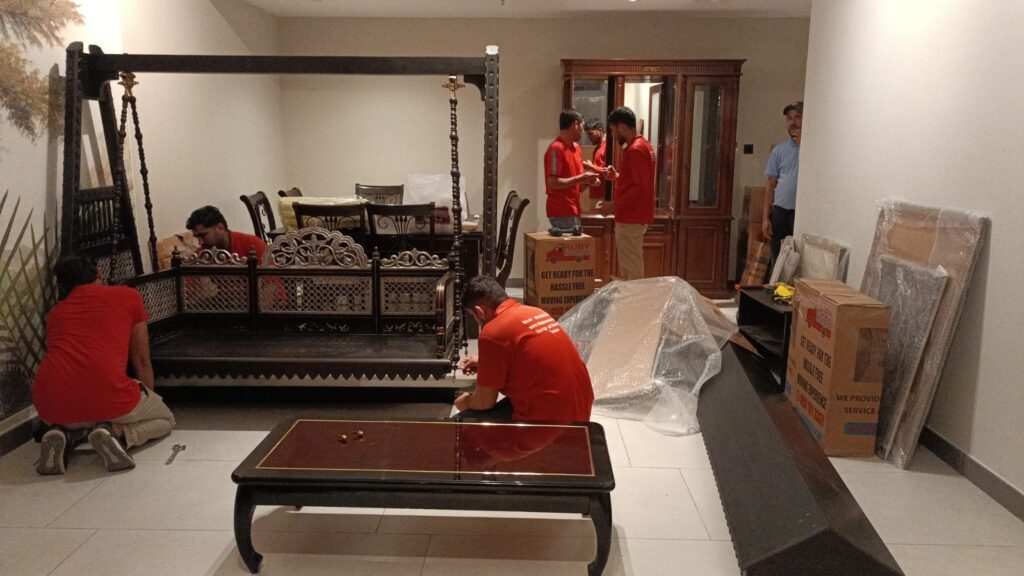Zero downtime office relocation keeps staff productive during cutover, with Recovery Time Objective and Recovery Point Objective met for every system. The UAE weekend pattern reduces user impact because federal entities adopted Saturday and Sunday as the weekend, with a Friday half day starting 1 January 2022. A Saturday–Sunday cutover lowers collisions with core business hours.
Power reliability in Dubai supports tight maintenance windows, with DEWA reporting 1.06 customer minutes lost in 2023 and 0.94 minutes in 2024. These figures frame facilities risk during rack moves. Organizations in the Middle East faced an average cost of $7.29 million, down from $8.57 million in 2024. A precise cutover weekend checklist for IT and Admin protects availability, data integrity, and user access.
What this guide covers: Scope for Office Relocation with Zero Downtime, the Cutover Weekend Checklist for IT and Admin, the single non-negotiable rehearsal step, UAE timing factors, power and cloud region facts, and auditor-ready evidence with metrics.

What is zero downtime in an office relocation for Dubai and the wider UAE?
Zero downtime means users keep access during the move while every system meets its Recovery Time Objective and every dataset meets its Recovery Point Objective. RTO is the maximum tolerable outage duration. RPO is the latest acceptable point in time for data recovery. Both definitions come from NIST SP 800-34 and the NIST CSRC glossary.
Why it matters in practice, authentication:
DNS, WAN, and SaaS carry the largest blast radius in office moves. RTO drives task order for network bring-up, identity, and storage. RPO fixes snapshot timing and data cut lines. Definitions come from NIST sources used by auditors.
Subsection: How RTO and RPO drive zero-downtime sequencing
Set RTO per system in minutes or hours. Set RPO per dataset in minutes or hours. Gate each cutover action against both values. Use tests, training, and exercises to validate timings before the weekend. NIST SP 800-84 describes TT&E programs for operational readiness.
Practical implications for the UAE moves
- Authentication, DNS, WAN, and SaaS hold the highest blast radius. Prioritize identity paths, name resolution, and connectivity during the first bring-up. NIST terminology frames the acceptance criteria.
- SLA context supports numeric goals. 99.9 percent availability maps to 43.2 minutes per 30-day month, so a weekend cutover targets near-zero service interruption.
- Local infrastructure reliability strengthens planning assumptions. DEWA’s 1.06 CML figure supports narrow power windows and documented UPS coverage.
What single control guarantees zero downtime on the cutover weekend?
A full end-to-end rehearsal with a timed rollback is mandatory because recognized standards require formal test, training, and exercise programs, and contingency plans that are proven with measurable results. NIST SP 800-84 defines TT&E events. NIST SP 800-34 embeds testing within contingency life cycles.
Evidence threshold for approval
Approval requires proof, not intent. A rehearsal converts assumptions into achieved Recovery Time Objective and achieved Recovery Point Objective. The exercise must generate timings, issues, fixes, and post-exercise evaluations that live in the change record. These artifacts match NIST SP 800-84 documentation practices.
Outage economics justify the effort. Uptime Institute’s 2024 analysis shows 54 % of significant outages cost more than 100,000 USD, and 16 % exceeded 1 million USD. A rehearsed rollback that completes within a fixed timer reduces impact duration if cutover degrades service.
Operational cadence for Dubai teams
Run three events that mirror the UAE weekend to match real access windows. Use Saturday and Sunday to reflect government and facilities schedules.
- Tabletop: Validate roles, communications, and a single authority for go or rollback. Capture a RACI and a decision tree.
- Lab dry run: Execute scripts for DNS, identity, storage, and voice. Time every step. Log defects with owners and retest dates.
- Full rehearsal with rollback: Execute the sequence and an intentional revert to the last known good. Measure achieved RTO per system and achieved RPO per dataset. Tie results to acceptance criteria.
Measured exit gates
- Achieved RTO is less than or equal to the planned RTO for each scoped system and for each dataset.
- Rollback completes inside a predefined timer with screenshots and configuration exports as proof.
Why rehearsal lowers incident probability
Change quality correlates with outcomes. The Accelerate research program tracks change failure rate as a key metric. Elite performers operate at a 0 to 15 % chance of failure across years of studies. Cutovers that rehearse end-to-end trend toward lower failure rates.
Availability expectations set a tight target. Microsoft’s Online Services SLA is financially backed at 99.9 percent for core services, which translates to about 43 minutes per 30-day month. Rehearsal helps keep the relocation inside that allowance.
Rehearsal components and audit-ready outputs
| Component | Objective | Quantitative proof |
|---|---|---|
| Tabletop exercise | Confirm roles, communications, and decision authority | Approved RACI, contact tree, and decision matrix saved to the change record |
| Lab dry run | Validate scripts and timings before production | Per-step timestamps, defect list with owners, retest confirmations |
| Full rehearsal | Prove operability and reversibility | Achieved RTO by system, achieved RPO by dataset, and the rollback timer met |
| Economic context | Quantify the impact of failure | >54% significant outages cost >100,000 USD, 16% >1 million USD |
| Service expectation | Align to availability targets | 99.9% SLA for Microsoft Online Services used by Dubai tenants |
Takeaways:
- Use a rehearsed rollback timer as a binary go or no-go control and store the proof in the change record.
- Require achieved RTO and achieved RPO from the rehearsal before approving cutover.
- Track change failure rate against the 0 to 15 percent elite band to monitor cutover readiness.
What audited proof secures zero downtime on the cutover weekend?
A timed end-to-end rehearsal with a documented rollback secures the decision. NIST SP 800-84 defines test, training, and exercise events with measurable outcomes. NIST SP 800-34 embeds testing in the contingency lifecycle that auditors reference.
Turn Relocation Risk into a Controlled Exercise
Outages carry a high cost. Uptime Institute’s 2024 analysis reports 54 percent of significant outages above 100,000 USD, and 16 percent above 1,000,000 USD. A proven rollback timer caps duration and limits loss exposure. Availability targets are strict. Change stability has reference bands. DORA research classifies elite change failure rate at 0 to 15 %. Rehearsed sequences correlate with lower failure probability during relocation.
Government entities operate a Saturday and Sunday weekend with a Friday half-day since 1 January 2022. A rehearsal that mirrors Saturday and Sunday improves realism for building access and support coverage.
Operational pattern for IT and Admin in the UAE
Run three events that mirror the production path. Capture numbers, owners, and evidence.
- Tabletop exercise: Confirm roles, communications, dependencies, and a single authority for go or rollback. Produce a RACI and a decision tree. Use TT&E documentation forms.
- Lab dry run: Execute scripts for DNS, identity, storage, voice, and WAN. Time each step. Log defects and retests. Generate a step timing sheet.
- Full rehearsal with rollback: Execute the cutover sequence end-to-end. Trigger a controlled revert to last known good. Record achieved RTO per system and achieved RPO per dataset.
Exit gates that unlock go live
- Achieved RTO is less than or equal to planned RTO for every scoped system and for every dataset.
- Rollback completes within a fixed timer with screenshots and configuration exports as proof.
- Rehearsal change failure rate aligns with DORA’s elite band at 0 to 15 %.
Focus points for the cutover weekend checklist
- Use the rehearsed rollback timer as a binary go or rollback control. Save proof in the change record.
- Align the rehearsal calendar with the UAE weekend for realistic access and support.
- Report achieved RTO and achieved RPO alongside SLA context and cost bands to leadership.
What grid facts in Dubai let IT plan a tighter cutover window?
Dubai’s electricity reliability is measurably high, so utility risk during the cutover weekend is low. Dubai Electricity and Water Authority reports Customer Minutes Lost of 1.06 minutes in 2023, and transmission plus distribution losses at 2 % in 2023. DEWA serves about 1.2 million electricity customers in Dubai.
Why these metrics matter for zero downtime
Low CML means fewer and shorter utility interruptions at the meter. That supports short, controlled power work during an office relocation cutover. DEWA confirms 1.06 minutes CML in 2023 and records losses from electricity networks at 2 %, compared with 6 to 7 % in Europe and the United States. Germany’s national regulator reports 12.8 SAIDI minutes for 2023, which shows Dubai’s single-digit figure sits well below common European bands. Use standardized indices such as SAIDI, SAIFI, and CAIDI in approval packs to keep reporting comparable.
Facilities impact for racks, MDF, and IDF
Plan narrow power down windows for cabinet moves and core switch swaps. Treat the DEWA numbers as context, not as the go decision. Prove site readiness with UPS autonomy tests, generator start logs, and per circuit load checks before any shutdown. Document results with timestamps and photos, then store them with the cutover record.
Targeted actions
- Align switching tasks to Saturday and Sunday to reduce user exposure in the UAE workweek model.
- Capture UPS discharge minutes and generator transfer timestamps for the new site.
- Record PDU load and headroom per rack against the power budget.
What this means for the cutover weekend checklist
- Cite DEWA CML and the 2 percent loss figure in the risk register to justify shorter maintenance windows.
- Keep site tests as the deciding control for zero downtime. Use SAIDI and CAIDI terms in evidence, then attach UPS and generator proofs to the change record.

How expensive is disruption for UAE enterprises, and what does that mean for the cutover weekend?
Disruption is costly in the Middle East, so the cutover weekend must minimize exposure. IBM reports the 2024 global average breach cost at USD 4.88 million, while 2025 coverage places the Middle East at USD 7.29 million, second after the United States. These accredited figures set the baseline for risk in Dubai office relocation.
Cost signals IT and Admin can use in the runbook
Regional costs are high, but they have been trending down since 2024. Press coverage of IBM’s 2024 cycle shows the Middle East at USD 8.75 million on average, which makes the 2025 estimate of USD 7.29 million a meaningful reduction. Outage economics remain severe across infrastructures. Uptime Institute’s 2024 survey shows 54 % of significant outages above USD 100,000, and about 16 % above USD 1 million. These numbers justify rehearsal with rollback, accelerated rollback timers, and staffed hypercare during office relocation.
Currency context for UAE executives
The dirham is pegged to the US dollar at 3.6725 AED per USD. Use this fixed rate to present exposure in AED without volatility assumptions. The Central Bank publishes daily rates and confirms the peg policy.
Applying the numbers to a zero-downtime cutover
Use regional benchmarks to size controls for the cutover weekend. Convert to AED, then estimate per-minute exposure for the approved change window. Record the model and the assumptions in the change record.
Example modeling steps for Dubai relocation:
- Start with the Middle East average breach cost: USD 7.29 million.
- Convert to AED at 3.6725: about AED 26.76 million.
- Choose a realistic exposure window for executive planning, for example, 240 minutes for a Saturday production change.
- Compute an exposure band per minute for slides: AED 26.76 million ÷ 240 ≈ AED 111,500 per minute. Note that this is a planning proxy, not IBM’s formula. Use it only to motivate rehearsal, rollback, and hypercare staffing.
What are the numbers that change in your cutover weekend checklist?
- Rehearsal with rollback. Treat the rehearsed rollback timer as a financial control that caps exposure if a step degrades service. Use the AED per-minute proxy to size the timer.
- Hypercare staffing. Justify on-site pods and a command bridge on Monday morning using the outage cost bands. Faster incident closure reduces time in the high-cost zone.
- Executive reporting. Add a single “go or rollback” slide with two bands: AED per minute at 240 minutes and at 120 minutes. Show how rehearsal shortens the band.
What is the cutover weekend checklist for IT and Admin in Dubai?
The checklist lists time-ordered tasks with owners, timestamps, and evidence. Keep answers direct. Keep sequencing linear.
T-14 to T-7 days: confirmations
- Freeze nonessential changes. Publish emergency approval path.
- Finish the rehearsal and the rollback. Capture achieved RTO and RPO per system.
- Confirm ISP dates, demarc, and diverse paths with e& and du. Save LOA and as-built drawings.
- Validate new site power. Note DEWA reliability figures in the risk context.
- Review Microsoft 365 Message Center for maintenance near the weekend. Export notices.
- Stage DHCP scopes, VLANs, VRFs, and routing.
- Stage SIP trunks, DID routing, and emergency-call parameters.
- Update asset inventory with serials and MAC addresses for chain of custody.
- Send the plan, contact tree, and bridge details to stakeholders.
- Prepare end-user messages for Friday, Saturday, and Sunday aligned with the UAE weekend.
Friday 12:00 GST: freeze and backups
- Announce the start of the cutover window across channels.
- Take last known-good backups and snapshots. Map them to RPO targets.
- Pin dashboards for latency, packet loss, jitter, CPU, memory, and IOPS.
- Export DNS, DHCP, firewall, and switch configs into a rollback pack.
Friday 18:00: decommission and pack
- Quiesce file services and queues. Drain batch jobs.
- Power down hardware per approved sequence.
- Label and seal equipment with room, rack, and U position.
- Photograph racks and cable paths for rebuild fidelity.
Saturday 08:00: site build and network bring-up
- Install core and access switches. Verify uplinks, STP, and LACP states.
- Bring up routers and WAN circuits. Validate BGP or static routing and failover.
- Stand up firewalls. Compare rules, NAT, and objects to exported baselines.
- Enable DHCP, DNS forwarders, and NTP.
- Verify Wi-Fi SSIDs, WPA2-Enterprise or WPA3, and RADIUS reachability.
- Test ISP failover and diverse paths. Record traceroutes and loss under load.
Saturday 14:00: server and voice cutover
- Power on servers. Validate hypervisor clusters and storage mounts.
- Re-IP services or update DNS records with low TTLs for fast propagation.
- Validate identity. Test AD replication, Entra Connect, and SSO flows.
- Cut over SIP trunks. Test inbound and outbound calls and emergency calls.
- Validate printing, badge access, and room systems.
Saturday 18:00: application validation
- Execute test scripts for line-of-business applications.
- Confirm Microsoft 365 access to Exchange Online, SharePoint, Teams, and OneDrive. Cite UAE data residency where configured.
- Run synthetic transactions for the top 10 user journeys.
- Record baseline performance with numeric thresholds.
Sunday 09:00: pilots and desks
- Floor-walk with 10 percent pilot users per department.
- Validate docking, monitors, VoIP handsets, label printers, and card readers.
- Confirm conference rooms, HDMI ingest, USB, BYOD, and Teams Rooms join.
- Publish floor maps and SSID guidance.
Sunday 14:00: readiness and go or rollback
- Review success criteria, open risks, and rollback timer.
- Confirm owner sign-offs.
- Send Monday 07:30 instructions with links for VPN, Wi-Fi, print, and room booking.
- Announce go or start rollback per the preapproved plan.
Monday 07:30: hypercare
- Staff the bridge and floor response pods.
- Track incidents per hour and MTTR.
- Send 10:00, 12:00, and 16:00 status updates with FAQs.
- Close the change after final business sign-off and evidence upload.
Conclusion: Lock the Weekend, Prove the Rollback, Open on Monday
Zero-downtime office relocation in Dubai depends on three measurable controls. Rehearsal with rollback proves the sequence. UAE weekend scheduling reduces user exposure. Evidence packs close the audit loop. RTO and RPO stay numeric for every system and dataset. DEWA reliability, Microsoft 365 availability commitments, and regional cost benchmarks frame risk and acceptance. The cutover weekend becomes a controlled exercise, not an ad hoc event. By Monday 08:00 GST, users access services, KPIs match baseline, and sign-off is complete.
Action summary
- Finalize the rehearsal plan with a timed rollback.
- Align cutover to Saturday and Sunday.
- Attach proofs: timings, screenshots, configs, Message center notices, UPS, and generator logs.
- Report achieved RTO and RPO against targets in a single acceptance table.
- Present AED exposure bands to leadership and close with a formal sign-off.
FAQs
What confirms zero downtime by Monday morning in Dubai?
Zero downtime is confirmed when RTO and RPO targets are met, no critical incidents occur, KPIs match baseline, and business acceptance is signed at or before 08:00 GST.
Why is a timed rollback non-negotiable for the cutover weekend?
A timed rollback caps the impact duration if a step degrades service. Rehearsal produces measured times and artifacts used for go or rollback approval.
How do the UAE weekend hours change the plan?
Saturday and Sunday carry lower business activity in the UAE public framework. Scheduling the change window on these days reduces collisions with core operations.
Which metrics belong in the evidence pack?
Include achieved RTO per system, achieved RPO per dataset, incident counts, user journey pass rate, latency, loss snapshots, and signed approvals.
What power facts justify tight maintenance windows in Dubai?
DEWA reports very low Customer Minutes Lost and low network losses. These figures indicate low utility risk during controlled shutdowns and restarts.
How do we size hypercare for Monday?
Use regional cost benchmarks and outage cost bands to justify a command bridge and floor pods. Faster response shortens high-cost minutes.
Where do latency-sensitive workloads sit for Dubai users?
Place them in the UAE North, Dubai, or the UAE Central, Abu Dhabi, where available. Keep identity, file, and voice paths in-region for lower round-trip time.
What SaaS checks matter before freeze?
Export Microsoft 365 Message Center notices for the weekend. Confirm no planned maintenance overlaps with DNS, identity, or voice changes.
Which tests validate site readiness for power work?
Run UPS discharge tests, capture generator start and transfer timestamps, confirm PDU headroom per circuit, and record photos with timestamps.
How does leadership see financial exposure in AED?
Convert regional averages to AED using the published peg. Divide by the planned change window to show exposure per minute on a single decision slide.





